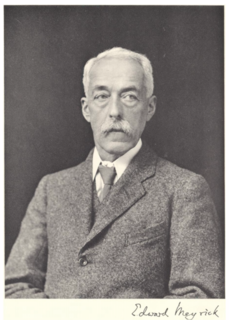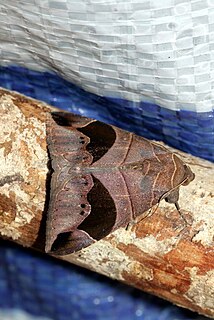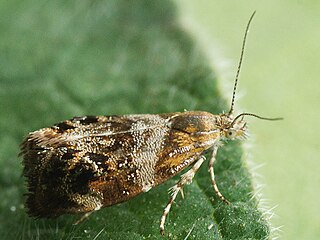
The Hepialidae are a family of insects in the lepidopteran order. Moths of this family are often referred to as swift moths or ghost moths.

Edward Meyrick FRS was an English schoolmaster and amateur entomologist. He was an expert on microlepidoptera and some consider him one of the founders of modern microlepidoptera systematics.

Arthur Gardiner Butler F.L.S., F.Z.S. (1844–1925) was an English entomologist, arachnologist and ornithologist. He worked at the British Museum on the taxonomy of birds, insects, and spiders.

Per Olof Christopher Aurivillius was a Swedish entomologist.

South Africa, officially the Republic of South Africa (RSA), is the southernmost country in Africa. With over 59 million people, it is the world's 24th-most populous nation and covers an area of 1,221,037 square kilometres. South Africa has three capital cities: executive Pretoria, judicial Bloemfontein and legislative Cape Town. The largest city is Johannesburg. About 80% of South Africans are of Black African ancestry, divided among a variety of ethnic groups speaking different African languages. The remaining population consists of Africa's largest communities of European, Asian, and multiracial ancestry.

Tytroca metaxantha is a moth of the family Erebidae first described by George Hampson in 1902. It is found in South Africa and Zimbabwe.

Bastilla joviana is a moth of the family Noctuidae first described by Stoll in 1782. It is found from the Oriental region to the Moluccas and in New Guinea and Australia. It is also present in South Africa.

Many populations of Lepidoptera migrate, sometimes long distances, to and from areas which are only suitable for part of the year. Lepidopterans migrate on all continents except Antarctica, including from or within subtropical and tropical areas. By migrating, these species can avoid unfavorable circumstances, including weather, food shortage, or over-population. In some lepidopteran species, all individuals migrate; in others, only some migrate.

Agrotis trux, the crescent dart, is a moth of the family Noctuidae. The species was first described by Jacob Hübner in 1824. It has a circum-Mediterranean distribution and is found along the coasts of France, Ireland, England, southern Europe, Algeria, Syria, Iraq, Iran, southern Russia and the Arabian Peninsula. In Africa, it is found as far south as South Africa.

Micragrotis interstriata is a species of moth of the family Noctuidae first described by George Hampson in 1902. It is found in Africa, including Zimbabwe and South Africa.
Heliothis galatheae is a species of moth of the family Noctuidae first described by Hans Daniel Johan Wallengren in 1856. It is found all over Africa, including South Africa to Ethiopia and the Gambia.

Heliothis leucosticta is a species of moth of the family Noctuidae first described by George Hampson in 1902. It is found in Africa, including Botswana and South Africa.
Heliothis sublimis is a species of moth of the family Noctuidae first described by Emilio Berio in 1962. It is found in Africa, including South Africa.
Heliothis transvaalica is a species of moth of the family Noctuidae first described by William Lucas Distant in 1902. It is found in Transvaal of South Africa and in Namibia.

Heliocheilus multiradiata is a species of moth of the family Noctuidae first described by George Hampson in 1902. It is found in Africa, including South Africa and Zimbabwe.

Appias epaphia, the diverse white or African albatross, is a butterfly of the family Pieridae. It is found in Africa, south of the Sahara. The habitat consists of forests and heavy woodland.
Titanoptilus stenodactylus is a moth in the family Pterophoridae first described by Thomas Bainbrigge Fletcher in 1911. It is known from South Africa, Tanzania, the Democratic Republic of the Congo and the Comoros.
The Micronoctuini are a tribe of moths in the family Erebidae that includes about 400 described species. Typical species in the tribe have bifine hindwing venation and are smaller than those in other noctuoid moths. Micronoctua karsholti is the smallest of all species in the superfamily Noctuoidea.
Louis Beethoven Prout (1864–1943) was an English entomologist and musicologist.

Tebenna bjerkandrella is a moth of the family Choreutidae first described by Carl Peter Thunberg in 1784. It is found from Europe, Morocco, Madeira and the Canary Islands through central Asia to Japan. It has also been recorded from South Africa.










